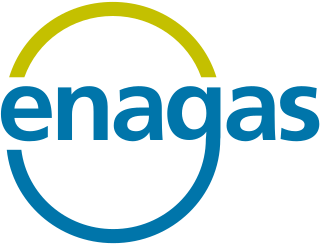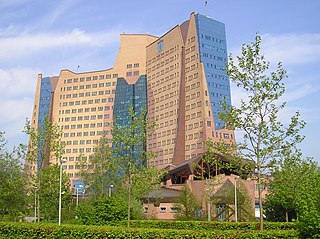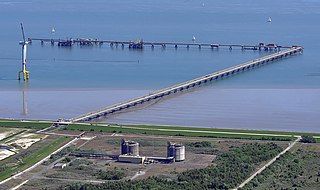Related Research Articles

Wilhelmshaven is a coastal town in Lower Saxony, Germany. It is situated on the western side of the Jade Bight, a bay of the North Sea, and has a population of 76,089. Wilhelmshaven is the centre of the "Jade Bay" business region and is Germany's main military port.

Brunsbüttel is a town in the district of Dithmarschen, in Schleswig-Holstein, northern Germany that lies at the mouth of the Elbe river, near the North Sea. It is the location of the western entrance to the Kiel Canal.

Liquefied natural gas (LNG) is natural gas (predominantly methane, CH4, with some mixture of ethane, C2H6) that has been cooled down to liquid form for ease and safety of non-pressurized storage or transport. It takes up about 1/600th the volume of natural gas in the gaseous state at standard conditions for temperature and pressure.

A floating production storage and offloading (FPSO) unit is a floating vessel used by the offshore oil and gas industry for the production and processing of hydrocarbons, and for the storage of oil. An FPSO vessel is designed to receive hydrocarbons produced by itself or from nearby platforms or subsea template, process them, and store oil until it can be offloaded onto a tanker or, less frequently, transported through a pipeline. FPSOs are preferred in frontier offshore regions as they are easy to install, and do not require a local pipeline infrastructure to export oil. FPSOs can be a conversion of an oil tanker or can be a vessel built specially for the application. A vessel used only to store oil is referred to as a floating storage and offloading (FSO) vessel.

Lubmin is a coastal resort in the German state of Mecklenburg-Vorpommern. Lubmin is situated near Greifswald and on the Bay of Greifswald.

Petronet LNG Limited is an Indian oil and gas company formed by the Government of India to import liquefied natural gas (LNG) and set up LNG terminals in the country. It is a joint venture company promoted by the Gas Authority of India Limited (GAIL), Oil and Natural Gas Corporation Limited (ONGC), Indian Oil Corporation Limited (IOC) and Bharat Petroleum Corporation Limited (BPCL). Petronet LNG Limited, one of the companies in the Indian energy sector, has set up the country's first LNG receiving and regasification terminal in Dahej, Gujarat, and another terminal in Kochi, Kerala. While the Dahej terminal has a nominal capacity of 17.5 million tonnes per year, the Kochi terminal has a capacity of 5 million tonnes per year. Plans to build a third LNG terminal in Gangavaram, Andhra Pradesh were dropped in October 2019.

Enagás, S.A. is a Spanish energy company and European transmission system operator (TSO), which owns and operates the nation's gas grid. The firm also owns four liquefied natural gas regasification terminals in the country, at Huelva, Barcelona, Cartagena, and Gijón. In addition, it owns 50% of the plant BBG (Bilbao) and 72.5% of the Saggas terminal in Sagunto. The chairman of Enagás is Antonio Llardén Carratalá and his chief executive officer is Arturo Gonzalo Aizpiri. The firm's headquarters are located in Madrid. Apart from Spain, Enagás has presence in Mexico, Perú, Chile, Sweden and in the Trans Adriatic Pipeline (TAP) European project.

N.V. Nederlandse Gasunie is a Dutch natural gas infrastructure and transportation company operating in the Netherlands and Germany. Gasunie owns the Netherlands gas transmission network with a total length of over 12,000 kilometres (7,500 mi) and 3,100 kilometres (1,900 mi) long network in Germany.
LNG Hrvatska d.o.o. is a company that operates a floating liquefied natural gas (LNG) regasification terminal in Omišalj on the island of Krk, Croatia. It commenced operations on 1 January 2021, with full capacity booked for the next three years.

Snam S.p.A. is an Italian energy infrastructure company.
Golar Spirit is a floating storage and regasification unit (FSRU). It is the world's first FSRU converted from a liquefied natural gas (LNG) carrier.
The Azerbaijan–Georgia–Romania Interconnector (AGRI) is a proposed project to transport Azerbaijani natural gas to Romania and further to Central Europe. Natural gas would be transported by the pipeline from Sangachal Terminal in Azerbaijan to the Kulevi Terminal at the Black Sea coast of Georgia. In Kulevi, the liquefied natural gas export terminal would be built. Liquefied natural gas will be transported by LNG tankers to the Constanța terminal in Romania. After regasification natural gas will be delivered through the existing gas grid to Romania and other European countries. Alternative to the transportation of liquefied natural gas is transportation of compressed natural gas.

The Świnoujście LNG terminal is a liquefied natural gas (LNG) import terminal at Świnoujście, in the extreme north-west of Poland near the Polish-German border. The LNG terminal is operated by Polskie LNG S.A., a subsidiary of Gaz-System. The cornerstone for construction was laid on 23 March 2011 and it took its first LNG delivery on 11 December 2015. The terminal's regasification capacity is 5 billion cubic metres per annum. The terminal is currently being expanded and once the expansion is complete in 2023, it will have a capacity of 7.5 billion cubic metres per annum and be able to satisfy about half of Poland's annual natural gas demand. Together with the 10 bcm of natural gas that Poland will receive annually from Norway via the Baltic Pipe natural gas pipeline, the Świnoujście LNG terminal will allow Poland to achieve its long-term goal of becoming fully independent of Russian natural gas, which had previously been the source of almost all of the country's natural gas.

A liquefied natural gas terminal is a facility for managing the import and/or export of liquefied natural gas (LNG). It comprises equipment for loading and unloading of LNG cargo to/from ocean-going tankers, for transfer across the site, liquefaction, re-gasification, processing, storage, pumping, compression, and metering of LNG. LNG as a liquid is the most efficient way to transport natural gas over long distances, usually by sea.

Klaipėda LNG terminal is an liquefied natural gas import terminal in the port of Klaipėda, Lithuania. It cost US$128 million to construct. The developer and owner of the project is KN Energies.
Deutsche Umwelthilfe e.V. is a non-profit environmental and consumer protection association, supported by public and private project grants and donations. It is a member of the European Environmental Bureau, in Brussels. It has the legal right to represent group claims in court against projects that it considers a threat to the environment. The group also aims to provide a forum for dialogue between environmental organizations, politicians and business people.

Wilhelmshaven LNG terminal is Germany's first liquefied natural gas (LNG) shipping terminal, situated near Wilhelmshaven, Germany on the North Sea. It had been in the planning stages since the mid-2010s, and in 2022 gained rapid regulatory authority approval for construction following the Russian invasion of Ukraine and the global natural gas supply crisis.
The Höegh Esperanza is a Floating Storage and Regasification Unit (FSRU) ship owned by Höegh LNG Holdings. Since the end of 2022 it is in use at the Wilhelmshaven LNG terminal.

Inkoo LNG terminal is a liquefied natural gas (LNG) shipping terminal, situated near Ingå, Finland on the Gulf of Finland. It became operational in January 2023, and received first gas in April 2023, with some shipments for Estonia. The floating regasification equipment and port facility was built to offload marine-shipped LNG to Finland following the cutoff of Russian pipeline gas in the aftermath of the 2022 Russian invasion of Ukraine, and will have the capability over time to supply gas to the Baltic countries as well.
References
- ↑ magazin, manager (August 2022). "LNG: RWE und Stena-Power werden Terminal vor Lubmin betreiben". www.manager-magazin.de (in German). Archived from the original on 4 October 2022. Retrieved 14 January 2023.
- ↑ NDR. "Habeck: Ab Mitte 2023 neues LNG-Terminal vor Lubmin". www.ndr.de (in German). Archived from the original on 2 October 2022. Retrieved 14 January 2023.
- 1 2 Becker, Andreas (7 September 2022). "Flüssiggas: LNG-Terminal des Bundes in Lubmin frühestens Ende 2023 fertig | Nordkurier.de". www.nordkurier.de (in German). Archived from the original on 6 October 2022. Retrieved 14 January 2023.
- ↑ "3,5 Milliarden Euro mehr: Deutsche LNG-Terminals kosten mehr als das Doppelte". FAZ.NET (in German). ISSN 0174-4909. Archived from the original on 14 January 2023. Retrieved 14 January 2023.
- ↑ Germany opens its 2nd liquefied natural gas terminal Archived 2023-01-30 at the Wayback Machine , ABC News, 14 January 2023.
- ↑ Third floating LNG terminal arrives in northern Germany Archived 2023-02-02 at the Wayback Machine , Deutsche Welle, 20 January 2023.